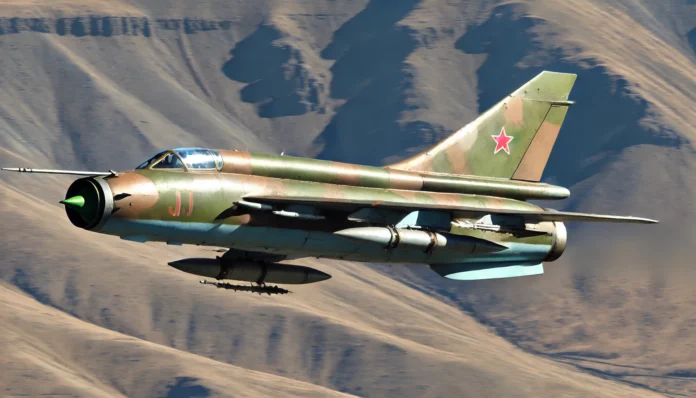The Su, known by its NATO reporting name “Fitter,” is a remarkable example of Soviet-era military engineering. Developed by the Sukhoi Design Bureau, this variable-sweep wing fighter bomber has left a significant mark on the history of military aviation. With a design lineage tracing back to the Su-7, the Su has been a versatile and reliable aircraft in numerous air forces worldwide. This article delves into the history, design, capabilities, and operational history of the Su.
A Brief History
The origins of the Su-22 can be traced back to the late 1960s. The capabilities of its existing Su-7B fighter bomber. Had limitations that needed addressing. The Sukhoi Design Bureau embarked on a project. To develop an advanced version with variable-sweep wings.
The prototype of the new aircraft, Su-17, took to the skies in 1969. After several iterations and enhancements, the Su variant was introduced in the mid-1970s, featuring upgraded avionics, and a more powerful and reinforced airframe.
Design and Features
One of the most distinctive features of the Su-22 is its variable-sweep wing design. This allows the pilot to adjust the angle of the wings in flight, optimizing performance for different phases of a mission. For takeoff and landing, the wings are swept forward, providing greater lift and stability at lower speeds. Reducing drag and allowing the aircraft to achieve higher speeds.

The Su is powered by a single Lyulka AL-21F-3 turbojet engine. Producing up to 17,600 pounds of thrust. This engine gives a maximum speed of approximately 1,200 miles per hour. (Mach 1.6) and a combat range of around 600 miles, depending on the payload and mission profile.
In terms of armament. The Su is equipped with a formidable array of weapons it can carry up to 8,800 pounds of ordnance on ten external hardpoints, including bombs, rockets, and guided missiles.
Operational History
The Su has seen extensive use in various conflicts around the world, demonstrating its versatility and reliability in combat. During the Iran-Iraq War in the 1980s, both sides operated Su-s, using them for ground-attack missions and air-to-air combat. The aircraft proved effective in delivering precision strikes against enemy targets, earning a reputation as a formidable ground-attack platform.
In the 1990s, the Su saw action in the Gulf War. Where Iraqi Su-‘s were employed against coalition forces although they faced formidable opposition from advanced Western aircraft. The Su-‘s managed to inflict damage on ground targets before being neutralized.
More recently, the Su-22 has been used in the Syrian Civil War with the Syrian. Air Force employs the aircraft for ground-attack missions against various rebel factions. Despite its age, the Su has continued to perform admirably. Demonstrating the robustness of its design and the effectiveness of its weaponry.
Legacy and Future
The Su-22 remains in service with several air forces worldwide, including those of Poland, Vietnam, and Syria. Modern aircraft have surpassed it in terms of technology and performance. The Su-‘s enduring presence in the skies is a testament to its design and capabilities.
Efforts to upgrade and modernize are ongoing, with some operators implementing avionics and weapons system enhancements to extend the aircraft’s service life. These upgrades aim to improve the Su-‘s combat effectiveness and ensure its relevance in contemporary conflicts.
Conclusion
The Su-“Fitter” stands as a symbol of Soviet-era engineering excellence and a testament to the ingenuity of the Sukhoi Design Bureau. Its variable-sweep wing design, robust performance, and formidable armament have made it a reliable workhorse in numerous air forces around the world. As it continues to serve in various capacities, the Su-‘s legacy as a versatile and effective fighter-bomber remains secure.




